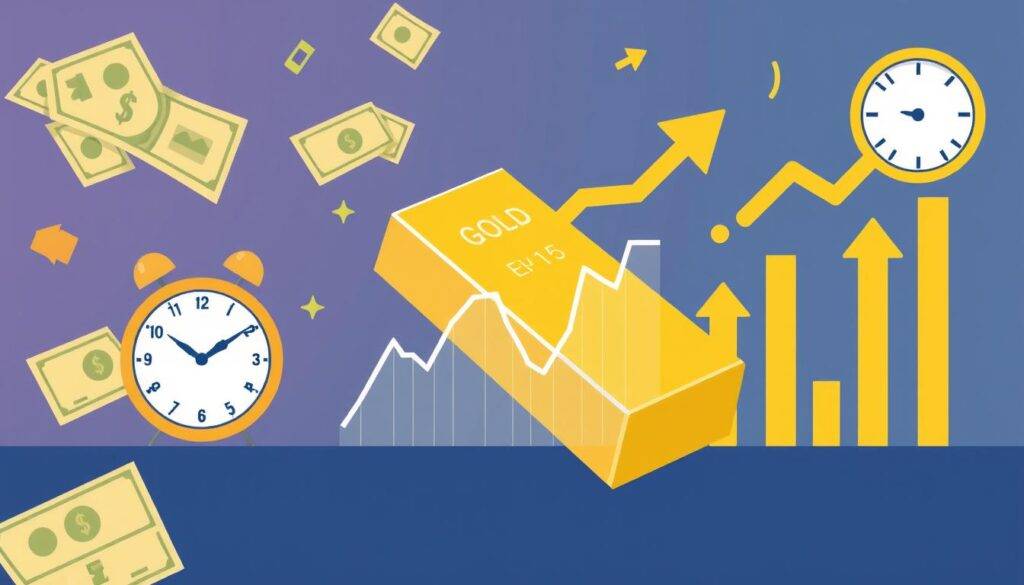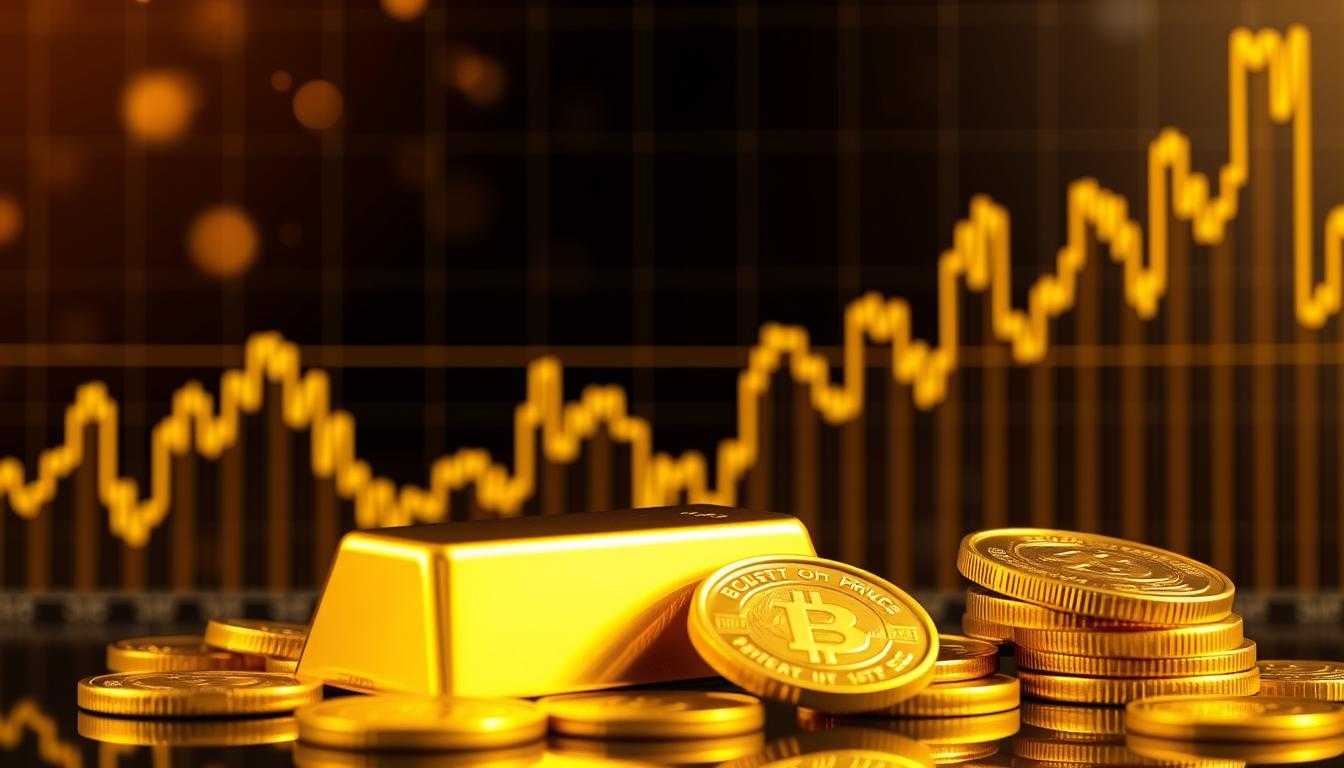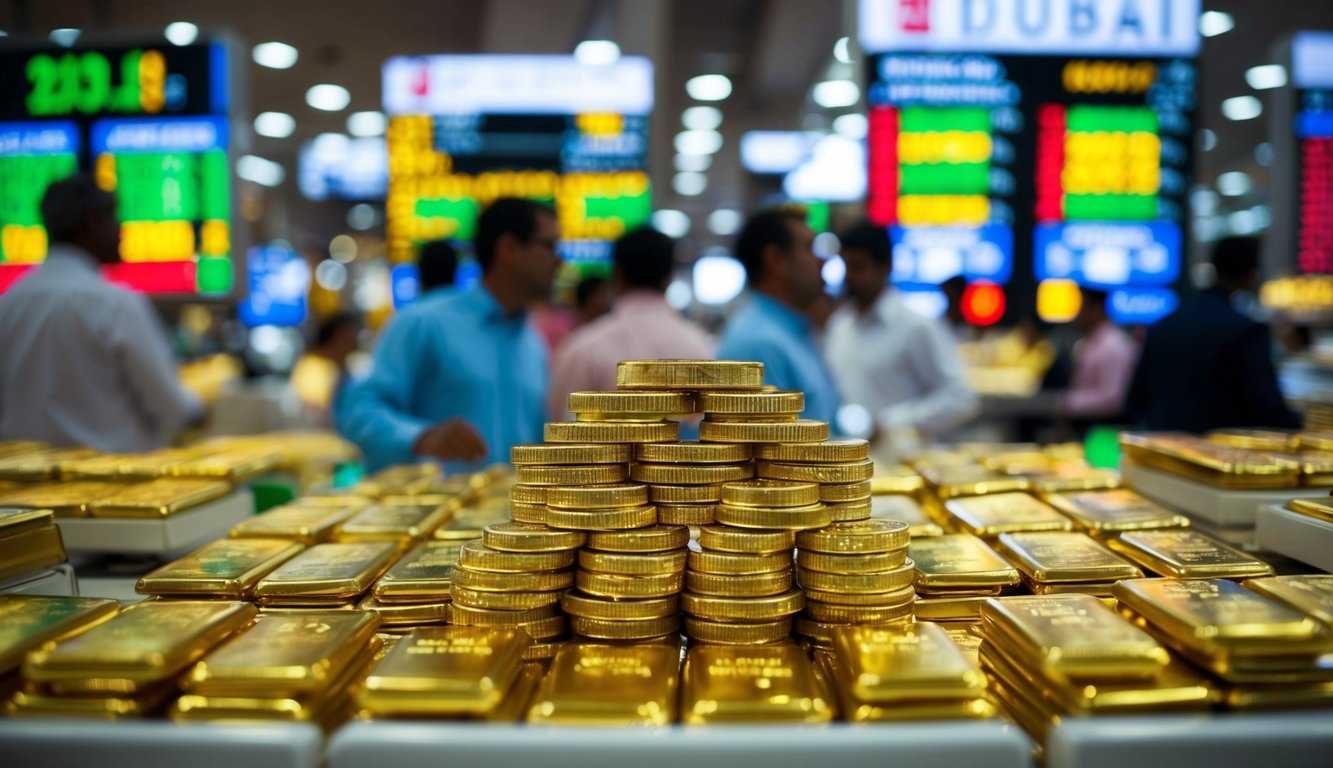Managing our wealth well means keeping up with different assets, like gold. The gold rate today is rising fast. This makes knowing how gold fits into wealth management more important than ever.
Experts say gold prices often go up by 8.5% six months after a rate cut. This, along with central bank buys and changes in policy, shows gold’s value in our plans. By October 2024, gold might hit $2,600 to $2,800 per ounce, making it a good choice for investors.
But, investing in gold has risks. Its value can change because of world events, the economy, and new rules. VanEck warns new investors about gold’s ups and downs. They say it’s key to know these risks before starting.
Yet, there’s a silver lining. Services like HDFC Bank’s SmartWealth help with financial planning. They make it easier to invest in gold. This helps us make better choices and grow our wealth.
Key Takeaways
- Gold prices could range between $2,600 and $2,800 per ounce by October 2024.
- Gold has historically appreciated by 8.5% after rate cuts since 2020.
- Investing in gold carries risks due to market volatility and economic conditions.
- Platforms like HDFC Bank’s SmartWealth can simplify gold investment processes.
- Understanding gold rate trends is essential for effective wealth management.
Understanding the Importance of Gold in Wealth Management
Gold is key in wealth management. It’s not just a valuable item but also a smart investment for diverse portfolios.
The Historical Significance of Gold
The historical significance of gold goes back to ancient times. It was prized for its rarity and value. From the Egyptians to the Romans, gold meant wealth and power.
In today’s world, gold’s value has grown by about 84% from 2014 to 2024. Its long-standing value is recognized by experts like VanEck. They see its worth during economic troubles and political instability. Central banks and financial groups hold almost one-fifth of the world’s gold, showing its ongoing importance.
Why Gold Remains a Safe Haven Asset
In uncertain times, gold is a safe haven asset. When stocks and bonds fall, gold prices often rise. This helps protect investors’ wealth.
Gold’s growth rate is impressive, with a 5.66% annual increase since 1971. This makes it a strong defense against inflation. Adding gold to a portfolio helps manage risks and aims for better long-term gains.
Gold’s history and role as a safe asset make it crucial for wealth management. It helps balance portfolios, reducing risks while aiming for higher returns.
| Metric | Value |
|---|---|
| Gold Appreciation (2014-2024) | 84% |
| Annualized Monthly Standard Deviation | 14.06% |
| Annualized CAGR (since 1971) | 7.81% |
| World’s Supply Held by Central Banks | ~20% |
Inflation’s Effect on Gold Prices
To understand how inflation affects gold prices, we need to look at history and current trends. In the past, inflation has led to gold prices going up. For example, in the 1970s, gold prices soared during a period of stagflation, showing gold’s value as a safe investment.

Experts suggest keeping 5-10% of your portfolio in gold to fight inflation. This approach has proven to be effective over the years, offering stability.
How Inflation Influences Gold Investments
Investing in gold during inflation is smart because of its past success. The European Central Bank says high inflation can slow down the economy. This makes investors turn to gold. For example, a recent survey showed more investors believe inflation will keep going up, which helps gold prices.
Gold usually goes up by about 15% a year when inflation is over 3%, according to the World Gold Council. But when inflation is low, gold’s gain is around 6% annually. This big difference shows how inflation affects gold’s value, making it key for investors in uncertain times.
Gold’s Performance During Inflationary Periods
Gold is known for staying stable during inflation. In 2008, for instance, gold prices jumped from under $500 to over $1,000 per ounce as inflation rose. This pattern repeated during the COVID-19 pandemic, when UK inflation hit 5.4%, also boosting gold prices.
The following data shows gold’s performance during inflationary times:
| Period | Inflation Rate | Gold Price Change |
|---|---|---|
| 1970s Stagflation | High | Surged Dramatically |
| 2008 Financial Crisis | Over 5% | +100% |
| COVID-19 Pandemic (2021) | 5.4% | Increased Substantially |
| 2023 (April) | High | Near Record Levels |
In conclusion, inflation has a big impact on gold prices. Whether looking at past data or investment advice, gold is a solid choice for investors during inflation. This shows the importance of carefully investing in gold to protect and grow your wealth.
The Benefits of Tracking Gold Rate in Wealth Management
Watching the gold rate can give investors key insights, especially when the economy changes. It helps us make smart choices about where to put our money. Knowing how gold prices move is especially important when inflation is high.
Financial advisors stress the link between gold prices and inflation. They use this to shape investment plans.
Enhancing Investment Decisiveness
Keeping an eye on gold rates makes us more decisive in investing. By watching these rates, we can guess market trends and tweak our portfolios. Investors usually put about 10% of their money in gold to spread out risks.
Gold’s ability to hedge against inflation and economic instability makes it key in smart wealth management.
Gold’s value has soared over time, hitting a record $2,672 per ounce in September 2024. This shows gold’s importance in a balanced investment plan. It boosts investor confidence, even when markets are shaky.
Protecting Portfolio Value
Tracking gold rates helps protect and grow our investments. VanEck suggests focusing on gold-related assets, like mining stocks, to shield against inflation.
Economic ups and downs often raise gold demand, affecting its price. People see gold as a safe investment during times when money’s value drops. This is why central banks are buying more physical gold.
We suggest using dollar-cost averaging for gold investments. This means buying gold at regular times, no matter the price. It helps keep your investment stable and strong.
Key Factors Affecting Gold Prices
Gold prices are influenced by many factors that investors watch closely. It’s important to understand how these factors work together. This knowledge helps investors navigate the gold market’s complexities.
Monetary Policies and Interest Rates
Central banks’ monetary policies greatly affect gold prices. Changes in interest rates, set by these policies, can cause gold prices to go up and down. Over the last 50 years, gold prices have moved with interest rates about 28% of the time.
In 1971, interest rates were 3.5%, but by 1981, they hit 16%. This rise in rates saw gold prices jump from under $200 to almost $2,000 per ounce. In 2023, gold prices went back up to $1,900 per ounce. This was due to hopes for slower Fed rate hikes and lower inflation.
Global Economic Uncertainties
Global economic issues, like wars and financial troubles, also affect gold prices. People often buy gold when things get tough, as seen in 1973 and 1974. Back then, gold prices soared over 60% while the S&P 500 Index fell by more than 20%.
Things like central bank buying, jewelry demand, and inflation worries also matter. For example, gold demand rose 15% to 2,335 tons in the first half of 2016. This was driven by political uncertainty and instability.
Fluctuations in the U.S. Dollar
The value of the U.S. Dollar has a direct opposite effect on gold prices. When the dollar is weak, more people want to buy gold. This is because they can buy more gold with their money, which can drive up prices.
In March 2022, gold prices hit $2,000 per ounce because of a weak dollar. But by the fall of that year, prices dropped to around $1,630 per ounce. This was because the Fed started raising interest rates. Gold prices also went up in 2023, showing this opposite relationship again.

Here’s a table showing how different factors have influenced gold prices over the years.
| Year | Interest Rates (%) | Gold Price ($/oz) | Key Economic Events |
|---|---|---|---|
| 1971 | 3.5% | ~$200 | Oil crisis |
| 1981 | 16% | ~$2,000 | High inflation |
| 2022 | Increasing rates | $2,000 | Fed rate hikes, weaker dollar |
| 2023 | Moderating rates | $1,900 | Slowdown in Fed rate hikes, moderating inflation |
In summary, monetary policies, global economic issues, and U.S. Dollar changes are key for investors to track gold prices.
Reading Gold Price Trends
Learning to read gold price trends means looking into the past and spotting patterns. By analyzing historical data, investors can guess future gold prices and plan their investments better.
Analyzing Historical Data
Looking at gold’s past gives us key insights. For example, during the Great Depression, gold prices jumped from $21 to $35 per ounce, a 67% rise. This pattern of price hikes during tough times was also seen in the 2008 Great Recession, where prices went from about $730 to $1,300 by October 2010.
Recent years show similar trends. Gold hit a new high of $1,825 in August 2011 due to the European debt crisis. Then, demand from China and inflation pushed prices over $2,265 per ounce in April 2024.
Recognizing Patterns and Making Predictions
Spotting patterns in gold prices is key for making good predictions. Gold prices usually go up when the economy is shaky and inflation is high. For example, gold prices jumped 27% from $1,575 in January 2020 to over $2,000 in the summer of 2020, during the COVID-19 pandemic.
Seasoned investors study these patterns to forecast the future. They look at how interest rate cuts have affected gold prices in the past. The all-time high of $3,300 (inflation-adjusted) in 1980 shows the importance of past data in predicting future trends.
Using tools like the LBMA Gold Price and indices like the US Dollar Index (DXY) helps forecast gold prices. These tools give a full picture of market trends and economic signs, crucial for solid gold investment plans.
Gold as a Hedge Against Economic Instability
Gold plays a key role in managing wealth, especially when the economy is unstable. It has long been a safe haven and a shield against inflation. The link between rising consumer prices and gold’s value is clear. For example, in 2022, gold demand jumped by 12% compared to the previous year, showing investors trust in gold’s stabilizing power.
When prices went up by 9.1% in the 12 months leading up to June 2022, gold shone. From November 2022 to February 2023, gold prices soared by 14%. This shows gold’s value as a reliable tool for managing risk. Its stability during economic ups and downs makes it a key part of a well-rounded portfolio.
Looking back at times of high inflation, gold’s worth is clear. From 1974 to 2008, during eight high-inflation periods in the U.S., gold prices went up by 14.9% each year. This is in contrast to the 1980-1984 period, when inflation was low and gold prices fell by 10% annually. This highlights gold’s inverse relationship with economic stability.
Gold’s performance varies compared to other assets. For instance, it sometimes lags behind real estate, commodities, and the S&P 500. Yet, its low or negative correlation with stocks and bonds makes it a strong diversifier. In Q3 of 2022, global gold demand surged by 28%, as reported by the World Gold Council. This shows gold’s ongoing role in managing economic risks.
| Time Period | Inflation Rate | Gold Price Change | Economic Scenario |
|---|---|---|---|
| 1974-2008 | High Inflation | Avg. +14.9% yearly | Unstable |
| 1980-1984 | Avg. 6.5% yearly | Avg. -10% yearly | Controlled |
| 2021-2022 | Avg. 6.8% yearly | Avg. +1% yearly | Unstable |
Investing in gold as a hedge against inflation and economic instability is wise. It helps balance portfolios and protect against market swings and downturns. This makes gold a crucial part of securing financial stability in uncertain times.
Practical Tips on Gold Investment
Gold investment is a smart way to diversify our portfolio and protect against economic risks. We can choose between physical gold and ETFs, each with its own benefits and drawbacks. Let’s explore some practical tips for gold investment and the tax benefits of Gold IRA.
Investing in Physical Gold vs ETFs
Choosing between physical gold and ETFs is key in gold investment. Physical gold, like bullion and coins, is a tangible asset with real value. It includes high-quality bars and coins like the American Gold Eagle.
However, physical gold has its downsides. It costs a lot to store, is hard to sell, and doesn’t earn income. On the other hand, ETFs and mutual funds that track gold are cheaper and easier to buy. They offer a way to invest in gold without the storage and security issues.
| Aspect | Physical Gold | ETFs |
|---|---|---|
| Liquidity | Low | High |
| Storage Costs | High (0.5% to 2%) | Low |
| Income/Dividends | None | Possible (depends on fund) |
Leveraging Tax Benefits with Gold IRA
Adding Gold IRA to our investment plan can save us a lot on taxes. Gold IRAs let us hold physical gold in a tax-free retirement account. This can help us keep more of our wealth.
Gold IRAs offer big tax benefits. Contributions to a traditional Gold IRA might be tax-deductible. The growth of our investment is also tax-free until we withdraw it. Plus, Gold Roth IRAs let us withdraw tax-free, under certain conditions. This makes Gold IRAs a great way to diversify and save on taxes during retirement.
Regional Gold Rates: UAE, Dubai, and Saudi Arabia
Gold’s influence reaches far, especially in the UAE, Dubai, and Saudi Arabia. These places are key for investors to watch trends and predict the economy. For example, the gold rate Saudi Arabia often shows global trends, helping international investors.

The gold rate in the UAE, especially Dubai, is closely watched. On July 10, 2024, one gram of 24k gold in Dubai cost AED 245, or about INR 5,579.45. This price is competitive worldwide. For instance, gold is more expensive in Malawi, Australia, and Indonesia, making Dubai attractive for investors.
| Region | Gold Price per Gram (24k) |
|---|---|
| Dubai | INR 5,579.45 |
| Malawi | INR 6,346.63 |
| Australia | INR 6,347.32 |
| Colombia | INR 6,351.73 |
| Indonesia | INR 6,359.47 |
Our analysis shows trends in the UAE and Saudi Arabia. The gold rate in Dubai is key for investors worldwide. Dubai is chosen for its lower gold bullion prices, thanks to lower making charges and high purity. Including these trends in investment strategies is crucial.
Central banks in places like Saudi Arabia affect the gold rate Saudi Arabia. Understanding these regional dynamics helps us see the international gold market’s subtle shifts. Watching the gold rate Dubai and the gold rate UAE gives us important clues for global economic indicators.
Using Technology to Track Gold Rates
Technology has changed how we watch and invest in gold. Gold prices have gone up by nearly 29% this year, hitting over $2,600 per ounce. This makes it key to track prices in real-time. Platforms using technology give us quick and accurate updates.
Mobile Applications
Mobile apps for gold prices have made it easier for investors to access information. These apps give live prices, spreads, and news. This helps investors make smart trades anytime, anywhere.
These apps are easy to use, even for beginners. They also have strong security and fast order execution. For example, HDFC Bank’s SmartWealth app lets users track their gold investments in real-time.
Online Platforms and Reports
Online finance sites have made gold investing more data-driven. They offer detailed reports and predictions. By looking at past data, investors can make smarter choices.
Gold ETFs are great for quick trades because they’re cheap and liquid. Online reports help investors stay on top of market changes. Sites like TradingView offer advanced tools for analyzing charts and trends.
When picking trading platforms, look for security, ease of use, and fast data. These features help investors navigate the gold market confidently. Real-time tracking is crucial for successful gold trading.
Conclusion
Tracking gold rates is key for smart wealth management. It helps investors stay financially stable and make informed choices. Gold is a safe asset that adds value to a diversified portfolio.
Gold is great for protecting against inflation and economic downturns. Holding 10-15% of your portfolio in gold can offer crisis protection. Even with higher costs, gold can act as a financial shield.
Knowing the difference between physical gold and ETFs is important. Gold IRAs offer tax benefits. Mobile apps and online platforms give us real-time gold price updates. These tools help us make better investment decisions, leading to financial stability and prosperity.
FAQ
What is the significance of tracking the gold rate in wealth management?
Tracking gold rates helps investors make smart choices. It ensures they take advantage of market chances for better wealth management and diversification.
How has gold served as a historical asset for wealth preservation?
Gold has kept its value through history. It’s seen as a stable and reliable investment worldwide, especially in tough economic times.
Why is gold considered a safe haven asset?
Gold is known for staying stable in shaky markets. It’s a top choice to protect against market drops and currency loss.
How does inflation influence gold investments?
Gold’s value often goes up when inflation rises. It acts as a shield against currency loss. History shows gold prices tend to climb after rate cuts.
How does gold perform during inflationary periods?
Gold usually keeps or grows its value during inflation. It’s a strong defense against inflation, keeping investment portfolios safe.
Why is tracking gold rate essential for investment decisiveness?
Keeping an eye on gold rates lets investors make quick, smart choices. It helps them adjust their portfolios to protect and grow their investments.
How does gold protect portfolio value during economic instability?
Gold’s performance is often different from other investments during economic troubles. This helps manage risks and keep portfolio value safe.
How do monetary policies and interest rates affect gold prices?
Changes in monetary policies, like interest rate cuts, impact gold prices. Lower rates often lead to higher gold prices as investors seek stable returns.
What is the impact of global economic uncertainties on gold prices?
Global economic worries and instability boost gold demand. This leads to price changes. Gold is a safe haven for investors in uncertain times.
How do fluctuations in the U.S. Dollar affect gold prices?
The U.S. Dollar and gold prices move in opposite directions. A weaker dollar means higher gold prices, as gold is cheaper for investors with other currencies.
Why is analyzing historical data important in understanding gold price trends?
Historical data offers insights into past market actions. It helps forecast future trends, guiding investment strategies effectively.
How can investors recognize patterns to make predictions about gold prices?
By examining historical charts and trend analyses, investors can spot patterns. This helps them predict market shifts and make informed investment choices.
How does gold act as a hedge against economic instability?
Gold’s liquidity and value retention make it a solid hedge in economic instability. It helps mitigate risks and stabilize investment portfolios.
Should I invest in physical gold or ETFs?
Physical gold offers direct ownership but comes with storage and insurance risks. ETFs provide a convenient, market-based option with easier liquidity and no storage needs.
What are the tax benefits of leveraging a Gold IRA?
Gold IRAs offer tax-deferred options. They allow investors to optimize taxes through strategic asset placement, planning for future financial benefits.
What are the current gold rates in UAE, Dubai, and Saudi Arabia?
Gold rates in these areas change with global market trends. Regularly checking these rates is key to understanding local investment chances and economic signs.
How can technology help in tracking gold rates?
Tech tools like mobile apps and online platforms give real-time gold price updates. They help investors make informed decisions and manage portfolios easily.
What are the advantages of using mobile applications for tracking gold prices?
Mobile apps offer easy, on-the-go access to gold price updates. They let investors stay informed and make timely investment decisions anywhere.
How do online platforms and reports aid in gold investment?
Online platforms provide detailed reports and tools for tracking gold investments. They help investors analyze trends, plan strategies, and manage wealth efficiently.




